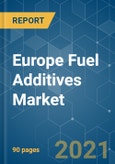The Europe fuel additives market is estimated to witness a significant growth, at an estimated CAGR of around 4%, over the forecast period. Major factors driving the market studied are the enactment of stringent environmental regulations.
Key Market Trends
Gasoline to Dominate the Market
Germany to Dominate the Market
Competitive Landscape
The Europe fuel additives market is partially consolidated in nature. The major companies include Afton Chemical, The Lubrizol Corporation, BASF SE, and LANXESS, among others.
Reasons to Purchase this report:
This product will be delivered within 2 business days.
- Increasing demand and penetration of battery electric vehicles (BEVs) are projected to hinder the market growth in the coming years.
- Accelerating demand for ultra-low-sulfur diesel (ULSD) is likely to create opportunities to the market in the future.
- Germany accounted for the largest market share and is expected to continue domination during the forecast period.
Key Market Trends
Gasoline to Dominate the Market
- Gasoline is the major application of fuel additives in terms of market share. Gasoline engine technologies and fuels are constantly evolving and providing new challenges. The growth in the consumption of gasoline additive largely reflects the requirements of engine design and developments in refinery operations. Also, the additive cost is less than 0.3% of the average retail gasoline price.
- The increasing popularity of new age fuel delivery systems, like gasoline direct injection (GDI) system, is likely to boost the demand for fuel additives.
- Port injection fuel delivery systems used to be the norm. However, new gasoline direct injection or GDI technology is becoming standard equipment on many new cars, especially in high-performance vehicles. In this innovative fuel delivery system, the injector is placed inside the combustion chamber yielding improved combustion to produce better performance, improved gas mileage, and fewer emissions. Deposits in GDI systems are extremely hard to remove and require more fuel additives.
- The market penetration of gasoline direct injection (GDI) engines is growing rapidly, which is quite instrumental in propelling the market demand for gasoline fuel additives, in significant amount.
- Hence, owing to the above-mentioned reasons, the gasoline-related applications of fuel additives are likely to account for the highest market share, during the forecast period.
Germany to Dominate the Market
- Germany leads Europe’s automotive market with 41 assembly and engine production plants that contribute to one third of the total automobile production in Europe.
- Germany, being one of the leading manufacturing bases for the aircraft industry, is the home to manufacturers from different segments, such as equipment manufacturers, material and component suppliers, engine producers, and whole system integrators.
- The German aerospace industry comprises more than 2,300 firms located all around the country, with northern Germany being the area with a higher concentration of firms.
- The country hosts a large number of production bases for aircraft interior components, MRO (maintenance, repair, and overhaul), and lightweight construction and materials, largely in Bavaria, Bremen, Baden-Württemberg, and Mecklenburg-Vorpommern.
- It has been estimated that over 30 to 35 thousand new aircraft will be operational by the next 20 years, in order to meet the rising aviation demand. Thus, with the increase in production of aircraft, the consumption of fuel additives will increase during the forecast period.
- Due to all such factors, the market for fuel additives in the country is expected to have a steady growth during the forecast period.
Competitive Landscape
The Europe fuel additives market is partially consolidated in nature. The major companies include Afton Chemical, The Lubrizol Corporation, BASF SE, and LANXESS, among others.
Reasons to Purchase this report:
- The market estimate (ME) sheet in Excel format
- 3 months of analyst support
This product will be delivered within 2 business days.
Table of Contents
1 INTRODUCTION
4 MARKET DYNAMICS
5 MARKET SEGMENTATION
6 COMPETITIVE LANDSCAPE
7 MARKET OPPORTUNITIES AND FUTURE TRENDS
Companies Mentioned (Partial List)
A selection of companies mentioned in this report includes, but is not limited to:
- Afton Chemical
- Baker Hughes, a GE Company LLC
- BASF SE
- Chevron Corporation
- Clariant
- Croda International Plc
- Eni SpA
- Evonik Industries AG
- Exxon Mobil Corporation
- LANXESS
- Royal Dutch Shell plc
- The Lubrizol Corporation
- Total
- VeryOne SaS (EURENCO)
Methodology

LOADING...








